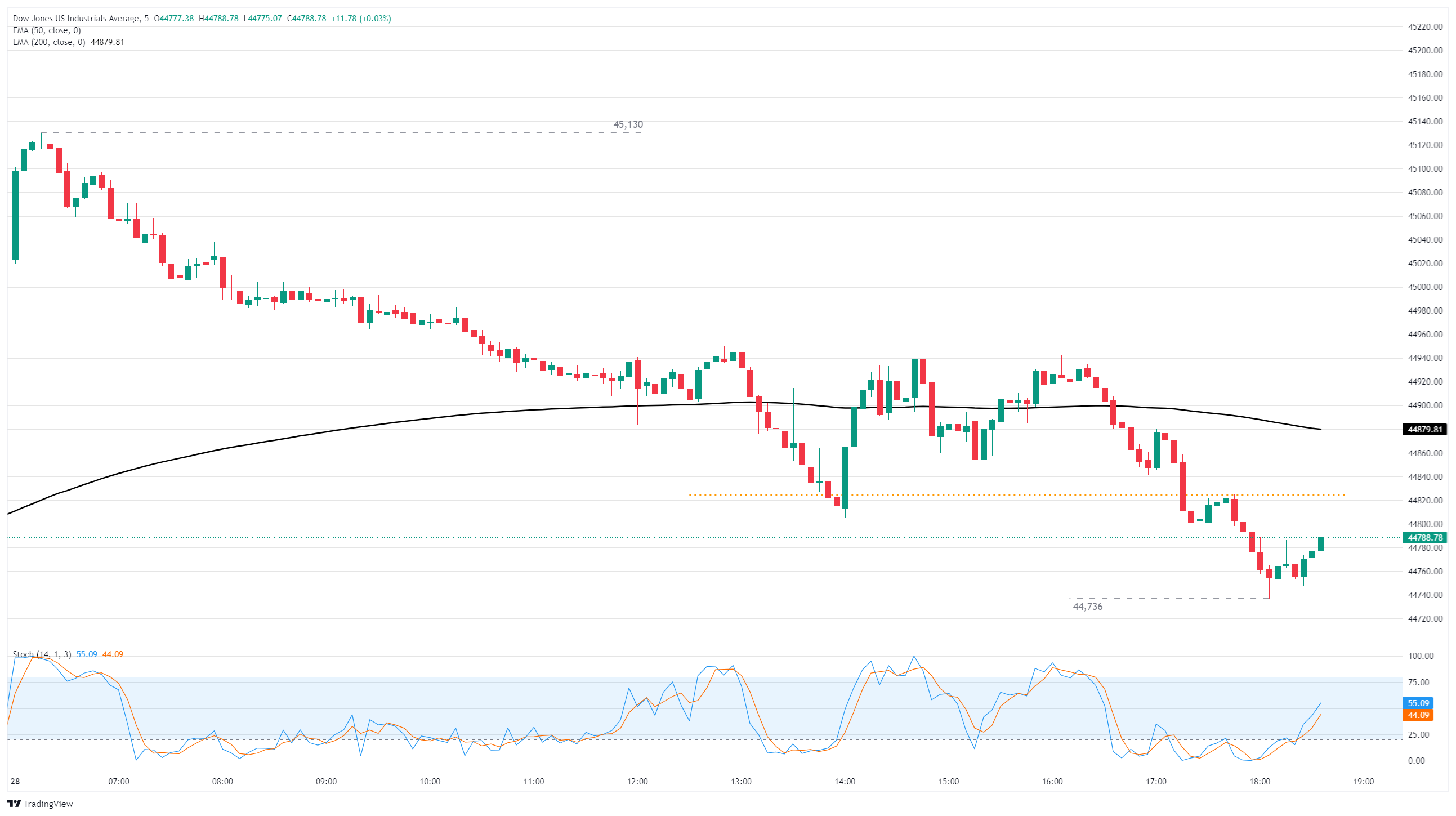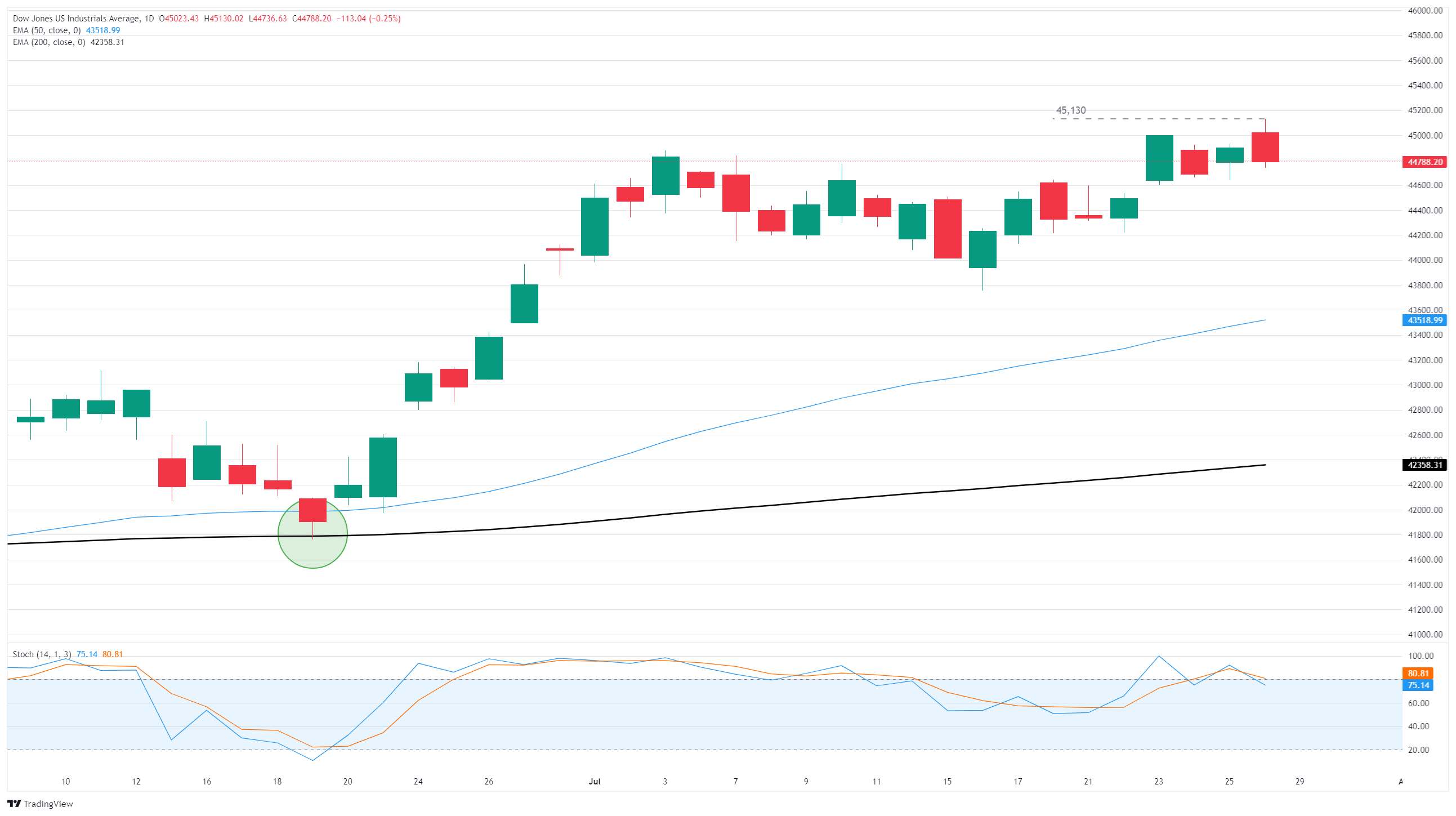Created
: 2025.07.29














![]() 2025.07.29 03:50
2025.07.29 03:50
The Dow Jones Industrial Average (DJIA) tested all-new record highs early Monday, clipping into the high side in early trading before the weight of the upcoming week pushed investors back into familiar territory. A handful of Magnificent 7 (Mag7) companies will be posting their latest quarterly earnings this week, adding further high-impact events to an already burgeoning data docket.
The Dow Jones clipped a record high in intraday trading on Monday, tapping 45,130 for the first time ever before slumping back into last week's congestion. The DJIA is now battling it out near 44,750 as investors gear up for a data and earnings-heavy week. The Dow is still buried deep in bull country, up over 22% from April's tariff-fueled bearish plunge to 36,615.
Facebook parent Meta Platforms (META) and computer services giant Microsoft (MSFT) will be holding their quarterly reviews on Wednesday, followed by Amazon (AMZN) and Apple (AAPL) on Thursday. The theme of the year will continue to be AI spending and services as investors begin to grow antsy about the justifications for companies to continue piling investment cash into AI projects.
United States (US) Gross Domestic Product (GDP) figures for the second quarter are slated to be released early on Wednesday, followed by the Federal Reserve's (Fed) latest interest rate decision. Annualized US GDP is expected to rebound to 2.4% from Q1's -0.5% print, while the GDP Price Index is forecast to ease to 2.4% from 3.8%. The Fed has been under increasing pressure from the Trump administration to trim interest rates fast and early, with President Donald Trump calling for a three-point reduction in the fed funds rate. Despite the White House's protestations, the Fed is broadly expected to keep interest rates on hold this week, with hopes for a quarter-point rate cut in September.
Core Personal Consumption Expenditures Price Index (PCE) inflation data from June will be released on Thursday. Headline inflation figures hit a bump and run through the second quarter, with much of the blame laid at the feet of the Trump administration's whipsaw trade and tariff policies. June's PCE inflation index is expected to tick upward once again, rising to 0.3% MoM from the previous 0.2%.
Friday will close out a heavy week with the latest US Nonfarm Payrolls (NFP) data. Median market forecasts expect a slight easing in headline job additions, with investors expecting around 110K net new employed positions in July compared to June's headline print of 147K.
Read more stock news: Nike leads Dow Jones higher after upgrade


The Dow Jones Industrial Average, one of the oldest stock market indices in the world, is compiled of the 30 most traded stocks in the US. The index is price-weighted rather than weighted by capitalization. It is calculated by summing the prices of the constituent stocks and dividing them by a factor, currently 0.152. The index was founded by Charles Dow, who also founded the Wall Street Journal. In later years it has been criticized for not being broadly representative enough because it only tracks 30 conglomerates, unlike broader indices such as the S&P 500.
Many different factors drive the Dow Jones Industrial Average (DJIA). The aggregate performance of the component companies revealed in quarterly company earnings reports is the main one. US and global macroeconomic data also contributes as it impacts on investor sentiment. The level of interest rates, set by the Federal Reserve (Fed), also influences the DJIA as it affects the cost of credit, on which many corporations are heavily reliant. Therefore, inflation can be a major driver as well as other metrics which impact the Fed decisions.
Dow Theory is a method for identifying the primary trend of the stock market developed by Charles Dow. A key step is to compare the direction of the Dow Jones Industrial Average (DJIA) and the Dow Jones Transportation Average (DJTA) and only follow trends where both are moving in the same direction. Volume is a confirmatory criteria. The theory uses elements of peak and trough analysis. Dow's theory posits three trend phases: accumulation, when smart money starts buying or selling; public participation, when the wider public joins in; and distribution, when the smart money exits.
There are a number of ways to trade the DJIA. One is to use ETFs which allow investors to trade the DJIA as a single security, rather than having to buy shares in all 30 constituent companies. A leading example is the SPDR Dow Jones Industrial Average ETF (DIA). DJIA futures contracts enable traders to speculate on the future value of the index and Options provide the right, but not the obligation, to buy or sell the index at a predetermined price in the future. Mutual funds enable investors to buy a share of a diversified portfolio of DJIA stocks thus providing exposure to the overall index.
![]()
Created
: 2025.07.29
![]()
Last updated
: 2025.07.29

FXStreet is a forex information website, delivering market analysis and news articles 24/7.
It features a number of articles contributed by well-known analysts, in addition to the ones by its editorial team.
Founded in 2000 by Francesc Riverola, a Spanish economist, it has grown to become a world-renowned information website.
We hope you find this article useful. Any comments or suggestions will be greatly appreciated.
We are also looking for writers with extensive experience in forex and crypto to join us.
please contact us at [email protected].
Disclaimer:
All information and content provided on this website is provided for informational purposes only and is not intended to solicit any investment. Although all efforts are made in order to ensure that the information is correct, no guarantee is provided for the accuracy of any content on this website. Any decision made shall be the responsibility of the investor and Myforex does not take any responsibility whatsoever regarding the use of any information provided herein.
The content provided on this website belongs to Myforex and, where stated, the relevant licensors. All rights are reserved by Myforex and the relevant licensors, and no content of this website, whether in full or in part, shall be copied or displayed elsewhere without the explicit written permission of the relevant copyright holder. If you wish to use any part of the content provided on this website, please ensure that you contact Myforex.
Myforex uses cookies to improve the convenience and functionality of this website. This website may include cookies not only by us but also by third parties (advertisers, log analysts, etc.) for the purpose of tracking the activities of users. Cookie policy